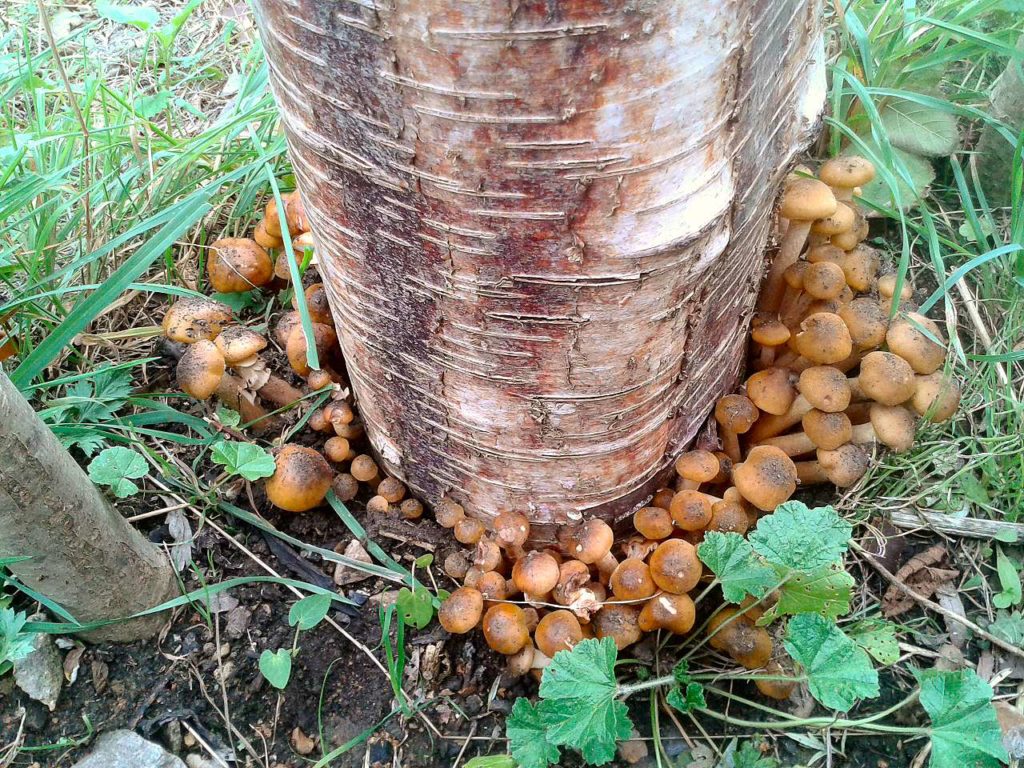
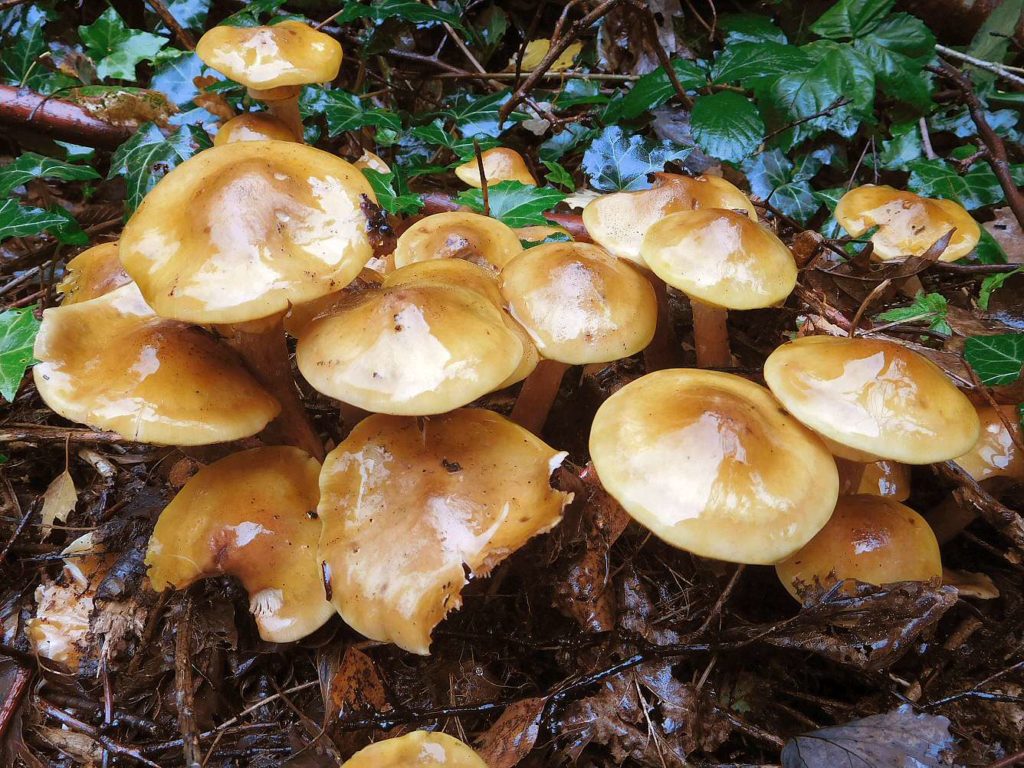
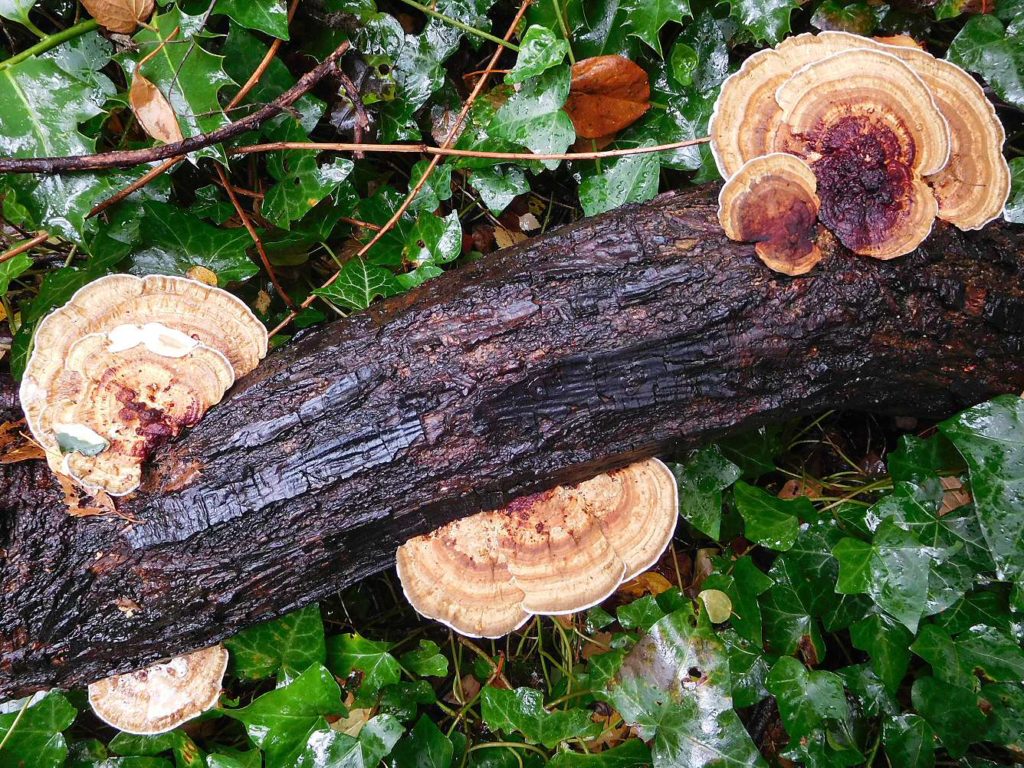
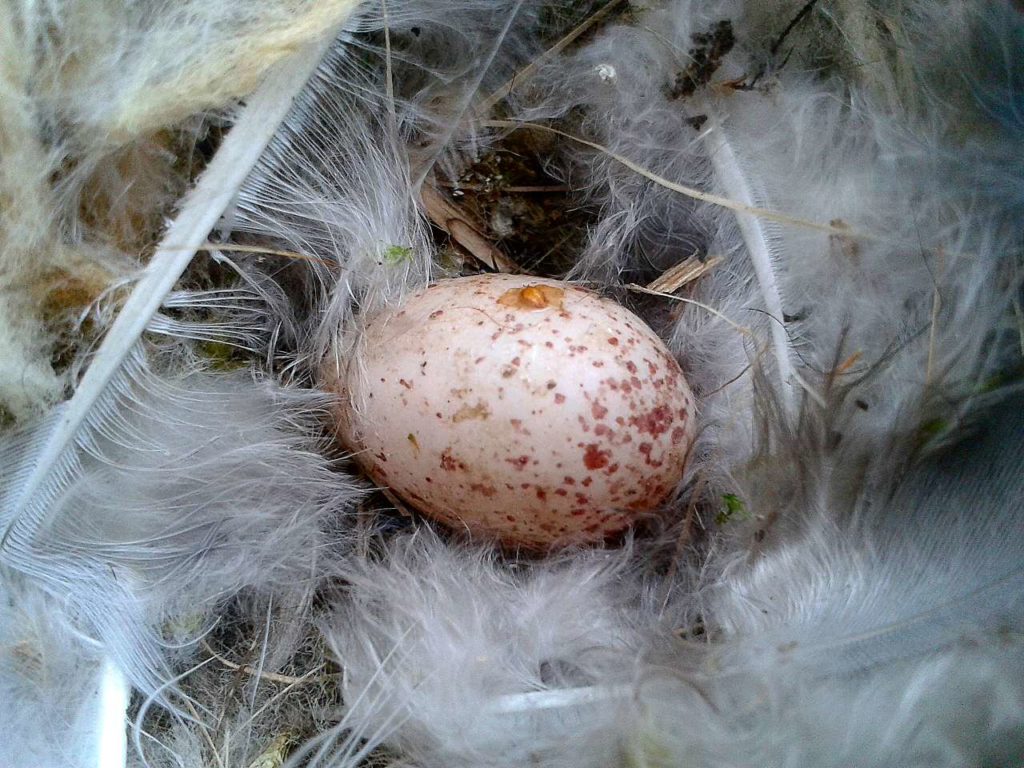
With another day of freezing fog, very dangerous on the roads, nature is telling us that, yes, global warming or no, it’s winter. The false acacia, totally leafless, whirs with activity. A big wood pigeon sits impassively, ignoring the small passers-by. Within a few minutes, these include 3 goldfinches, keeping well away from each other in the branches; 2 male blackbirds, similarly, their heads high on the lookout for competitive activity; 4 ring-necked parakeets, never settling for more than a moment, jumping up squawking at the slightest provocation; 2 redwings, handsome with their contrasting eyestripes; 1 fieldfare, markedly bigger, and a handsome bird when seen in crisp winter sunshine rather than today’s murky fog. A few minutes later, a blackcap appeared: still a bird that we think of as a summer visitor, though a few pass through in winter from colder places. Later still, a great tit jumped in and wriggled about; and a little flock of 6 starlings blew in for a few minutes, sadly diminished from the sort of flocks I remember: and even this local flock used to have 7 members.
The effect as birds appear from and vanish into the gloom is rather of one of those popular tales physicists tell to try to make the public feel they understand what nuclear physics is all about: particles and antiparticles are ceaselessly created by the vacuum, and as continuously meet each other and annihilate, returning to their matrix, the apparently endlessly creative fog, which one would otherwise have mistaken for chilly nothingness.
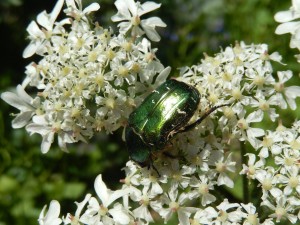
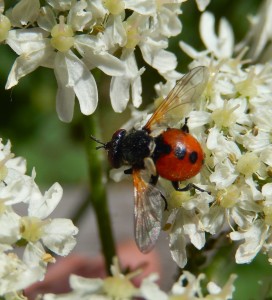
On this lovely hot day, we tried to work, hammering in pegs to fix path edging poles. When we were all a bit dizzy from the heat and effort, we gave up swinging the sledgehammer and had a tea in the hut. Then we did a butterfly transect, which in the absence of anything but Speckled Woods, turned into a nature walk as we photographed all the other interesting insects. The Rose Chafer (on hogweed) is worth looking at full-screen as it’s very pretty.
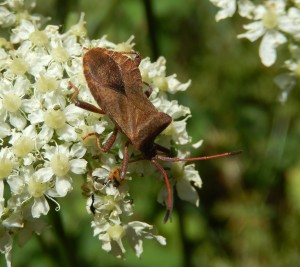
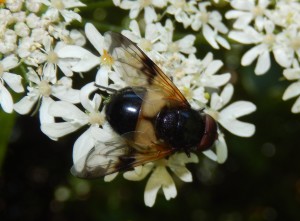
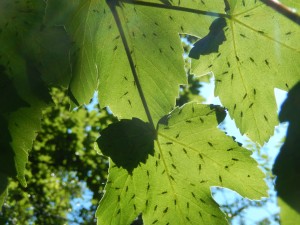
These aphids looked amazing with the sunlight streaming through the leaves; the leaves below were spattered with sticky sugar dropped by the aphids.
There was a beautiful Click Beetle too (like Athous haemorrhoidalis) but I didn’t photograph it as we were having too much fun making it go click and jump out of our hands.
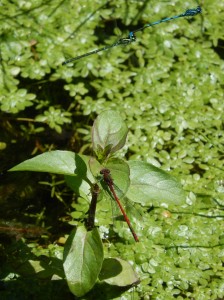
See the Red damselfly? Look up: there’s a pair of Azure damselflies hovering above. Well worth viewing full screen.
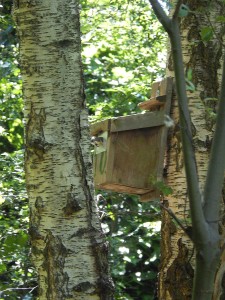
We were pleased (and somewhat surprised) to find a family of Great Tits in box 10, right beside the path, and not terribly high up either, but it was an old and presumably proven nest-site, and so it has proven again this year. I got a blurry photo of one of the proud parents entering the hole, which I had repaired with some aluminium sheet this winter.
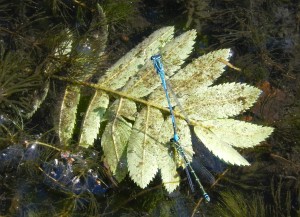
I was very pleased with this photo, with its surreal light and bubbles. I’ve not remarked the green female morph before: most Azure females seem to be a paler, more lime-green form.
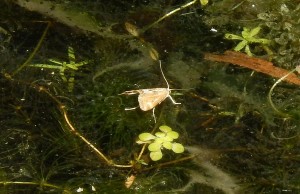
This last photo (taken at quite a distance) shows something very curious: the Brown China Mark, a micro moth that lays its eggs on pondweeds, scurrying over the surface of the water searching for suitable ovipositing sites. In the dazzling light, she was far more reflective than anything else, and I had to turn the exposure down two whole stops to get her about right. The larva is aquatic, feeding on pondweeds.
Not pictured: sawflies; a swift Ichneumon beside the pond (without a long ovipositor, but with a clearly clubbed abdomen); many bumblebees and striped hoverflies. Nests of Peacock butterfly caterpillars too.
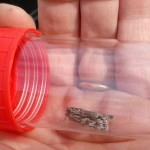
The dawn chorus at the reserve revealed two singing Blackcaps: one was alternately feeding on newly-emerged Cherry buds, presumably eating insect larvae, and giving short bursts of song or subsong. In a few days’ time the leaves will make such easy observation much less likely. There were two singing Chiffchaffs, one of them in full view in a Birch just coming into leaf above the main pond; and a Willow Warbler which I first heard yesterday near the picnic meadow.
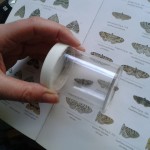
A party of newly-fledged Great Tits blundered about the bushes on the steps by the main pond, and a Wren gave me a fine view at the ‘mangrove swamp’, which is fast drying up. The newly-dug extension to the seasonal pond has filled with water and is in fact deeper than the rest of the pond, probably a useful variation in depth.
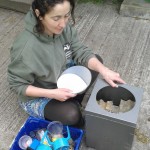
Up at the hut, the moth trap was being opened after a night’s work. Inside were some Pug moths, probably Brindled Pugs, and a much larger Noctuid moth, an Early Grey.
Also seen were Jay, Magpie, Carrion Crow, Wood Pigeon, singing Dunnock, Blackbird, Robin, Mallard. A Wren was carrying food to its nest near the ramp.
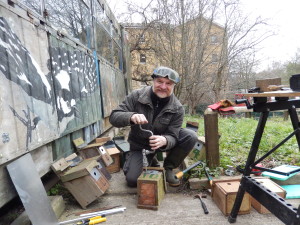
Quick! Spring is in the air, the Dunnocks are passionately singing their tuneless songs, the Great Tits are yelling Zi-Za-Zi-Za-Zi-Za endlessly, the Greenfinches are wheezing out their odd song (‘Zheee’), it’s time to fix those nestboxes. Most of those in the Gunnersbury Triangle had been “hammered” by Tits or Woodpeckers, or gnawed by squirrels. And a few had been rather roughly drilled by humans. So the warden decided that all of them should be given anti-squirrel plates; all, that is, except the Robin boxes, which have a wide rectangular opening in the front.
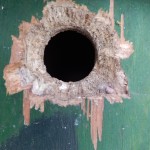
A few of the boxes seemed to have been attacked by squirrels. This one has what could be toothmarks and signs of extensive tearing of the wood outwards at a shallow angle, which looks like gnawing rather than hammering. It isn’t obvious why the basically herbivorous Grey Squirrel should do this.
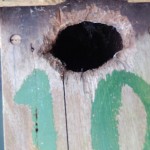
This box, on the other hand, seems to have been hammered at a sharp angle to the surface, whether by the Tits themselves (they certainly do this sometimes) or by Greater Spotted Woodpeckers preying on nests – although they mainly eat insects and seeds, they do take eggs and chicks when the opportunity arrives.
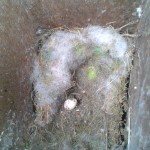
At least 4 of the nestboxes had substantial and reasonably fresh remnants of nests inside; this older one contained two long-addled tit eggs (just one shown here; it was 16 mm long) with a mixture of moss and down as insulation.
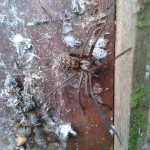
Finally, one very old nestbox, carefully engineered with beading around the hinged lid complete with little brass hooks, contained a Giant House Spider, Tegenaria, a lot of beetle pupae, and what could be Gypsy Moth pupae as well. The box was a messy tangle of thick sticky cobweb, and the spider was distinctly reluctant to leave, seeming to want to stand and fight off any intruder.
All in all, what might have seemed a mundane bit of metalwork turned out to be a day full of interesting natural history. (But the metalwork was fun, too.)

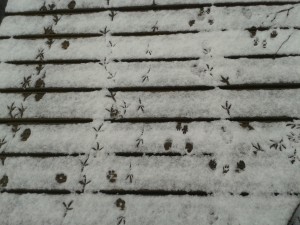
Today we woke to a snow-covered city, just a light dusting; and as often with snow, the weather was appreciably warmer than before the snow arrived.
Down at the nature reserve, the paths were empty of human footprints, but thickly sprinkled with animal tracks. Here some crows had walked to and fro across the path; there, a fox had jogged along the trail. But better was to come: the boardwalk across the pond was interlaced with tracks. On the left, a fox had gone the length of the boardwalk. In the centre, a crow had walked unsteadily along, the same way as me; and it, or another, had walked more rapidly back. On the right, more birds’ footprints: and the four-feet-together group of a squirrel, the smaller front prints clearly showing the marks of the sharp claws.
On a Birch branch above the anthill meadow, a Green Woodpecker hammered in search of food. Down by the ‘mangrove swamp’, a Jay screeched harshly, either for us or for a fox. Near the picnic meadow, a Sparrowhawk flew from its high perch, wheeled above the treetops, dived rapidly out of sight.
We carried tools and a ladder to visit the nestboxes and take down all that needed repairs. While I held the ladder, a party of four Long-Tailed Tits blew by, crossing from one Birch to the next one at a time. One of the boxes contained not just a mossy nest (like three others) but two old addled eggs, probably of Great Tit. While we struggled to prise off a somewhat too well attached box for maintenance, a Robin perched nearby, in hope of eating any grubs we might have disturbed. Several boxes had had their openings enlarged by much hammering by Blue Tits or Great Tits: nobody knows why they might do this, as it increases the threat to their nests from predators. We will make aluminium plates for the fronts of all the Tit boxes (the ones with circular holes): the Robin boxes just have a wide rectangular opening, which they definitely prefer. Inside one of the boxes was a mass of woodlice in the moss; another had a plump dead Noble False Widow Spider (Steatoda nobilis) inside.